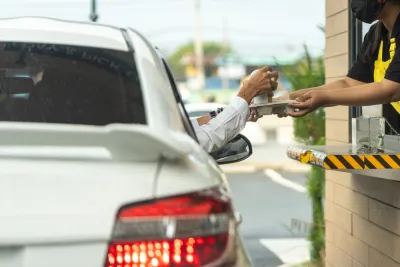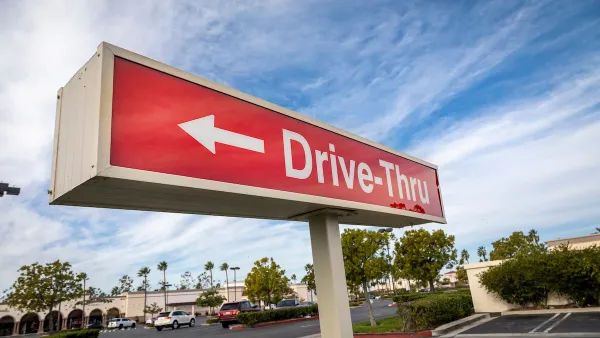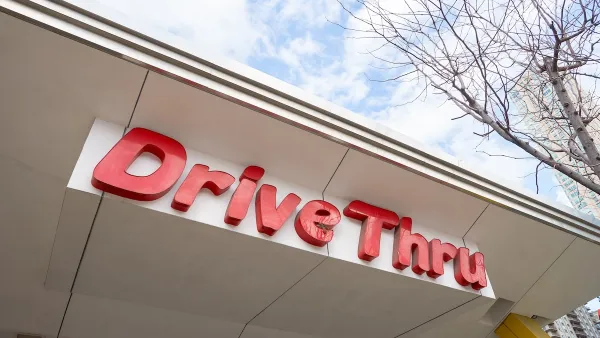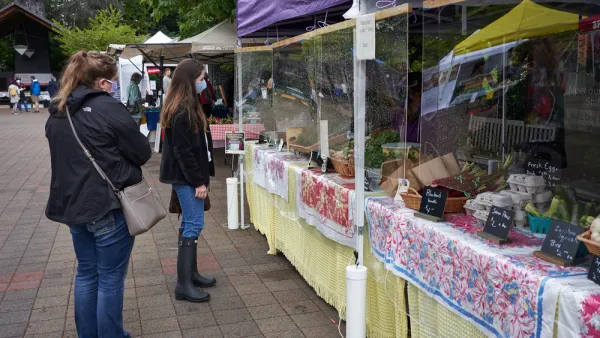Responding to pandemic-era shifts in customer demand, fast food and fast-casual chains are stripping away dining rooms, restrooms, and human cashiers in favor of drive-through and automated pickup options.

“Pushed by pandemic restrictions and pulled by the increasing ease of mobile transactions, customers have rushed into drive-thrus, delivery, and mobile ordering.” Consequently, writes Henry Grabar in Slate, most American fast food chains are opening “digital kitchens” with no indoor seating or in-person transactions. Emma Beckett, an editor at Restaurant Dive, says in addition to innovative new designs for new stores, “the arms race is on to remodel older stores with drive-thru lanes.”
Some chains are shifting to ‘ghost kitchens:’ “unmapped, closed-door facilities where food for delivery might be prepared for a dozen different brands at once.” In general, Americans are buying more prepared food than ever, with restaurant spending surpassing grocery spending for the first time in the 2010s.
Breakfast spending at coffee chains like Starbucks is the fastest-growing segment of the shift to eating out. “Despite its roots as an urban gathering place whose comfy chairs, Wi-Fi, and bathrooms invite customers to linger, on-and-off closures related to COVID have helped accelerate a business shift toward mobile, delivery, and drive-thru, which now make up almost three quarters of the brand’s U.S. revenue.”
“It’s not just mobile apps that are making these changes attractive, but an older technology that also promised both freedom and a kind of anti-social isolation: the automobile.” And with remote work making it possible to eat at home rather than in the office or on the go, it’s possible that, when it comes to where Americans want to spend their time, “nothing beats the kitchen table.”
FULL STORY: Take Your Fries and Leave

National Parks Layoffs Will Cause Communities to Lose Billions
Thousands of essential park workers were laid off this week, just before the busy spring break season.

Retro-silient?: America’s First “Eco-burb,” The Woodlands Turns 50
A master-planned community north of Houston offers lessons on green infrastructure and resilient design, but falls short of its founder’s lofty affordability and walkability goals.

Delivering for America Plan Will Downgrade Mail Service in at Least 49.5 Percent of Zip Codes
Republican and Democrat lawmakers criticize the plan for its disproportionate negative impact on rural communities.

Test News Post 1
This is a summary

Test News Headline 46
Test for the image on the front page.

Balancing Bombs and Butterflies: How the National Guard Protects a Rare Species
The National Guard at Fort Indiantown Gap uses GIS technology and land management strategies to balance military training with conservation efforts, ensuring the survival of the rare eastern regal fritillary butterfly.
Urban Design for Planners 1: Software Tools
This six-course series explores essential urban design concepts using open source software and equips planners with the tools they need to participate fully in the urban design process.
Planning for Universal Design
Learn the tools for implementing Universal Design in planning regulations.
EMC Planning Group, Inc.
Planetizen
Planetizen
Mpact (formerly Rail~Volution)
Great Falls Development Authority, Inc.
HUDs Office of Policy Development and Research
NYU Wagner Graduate School of Public Service





























